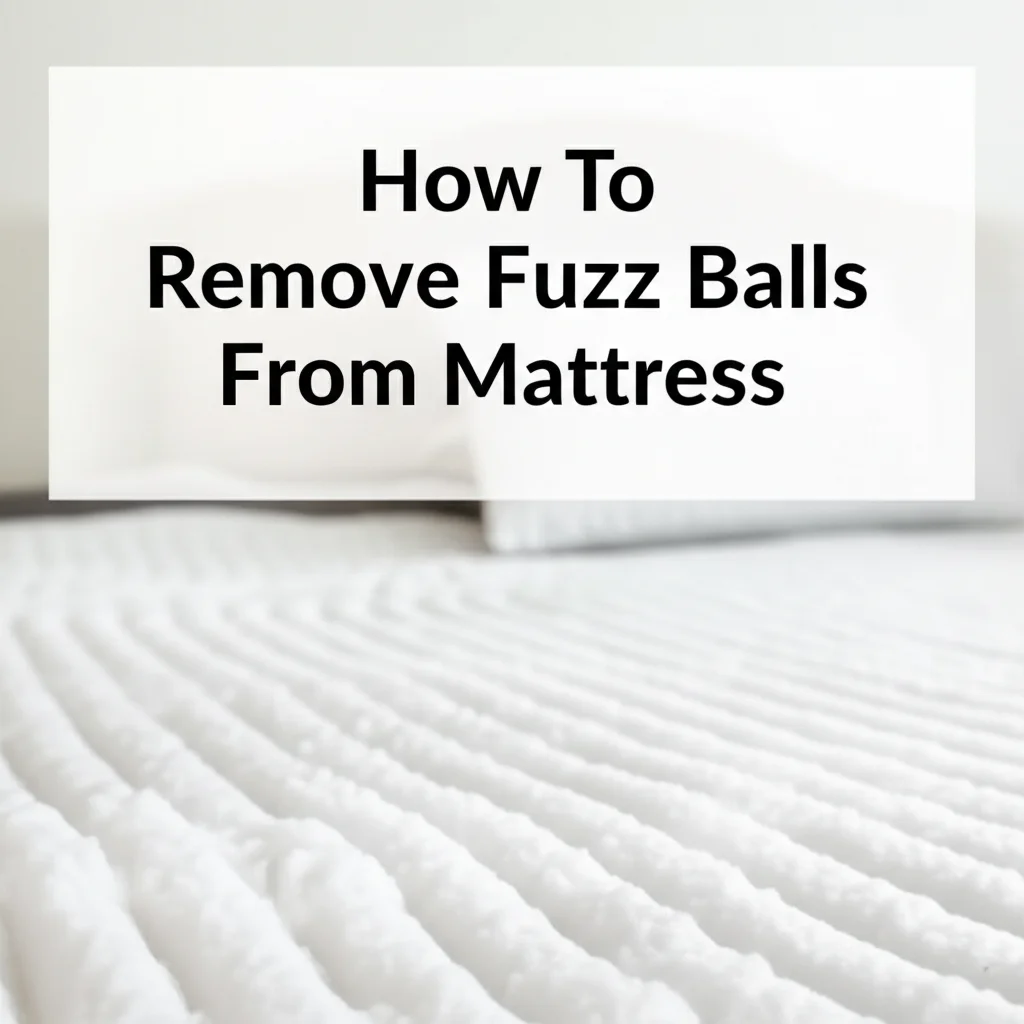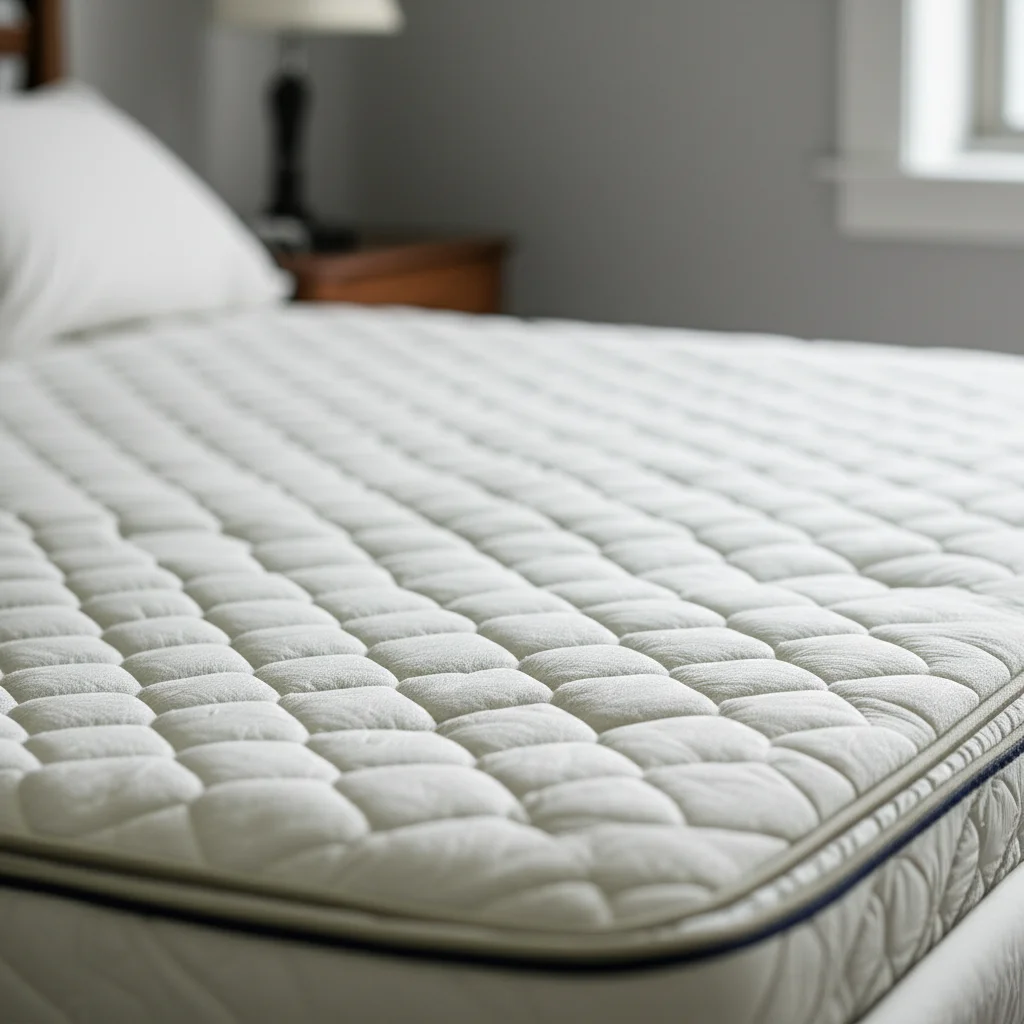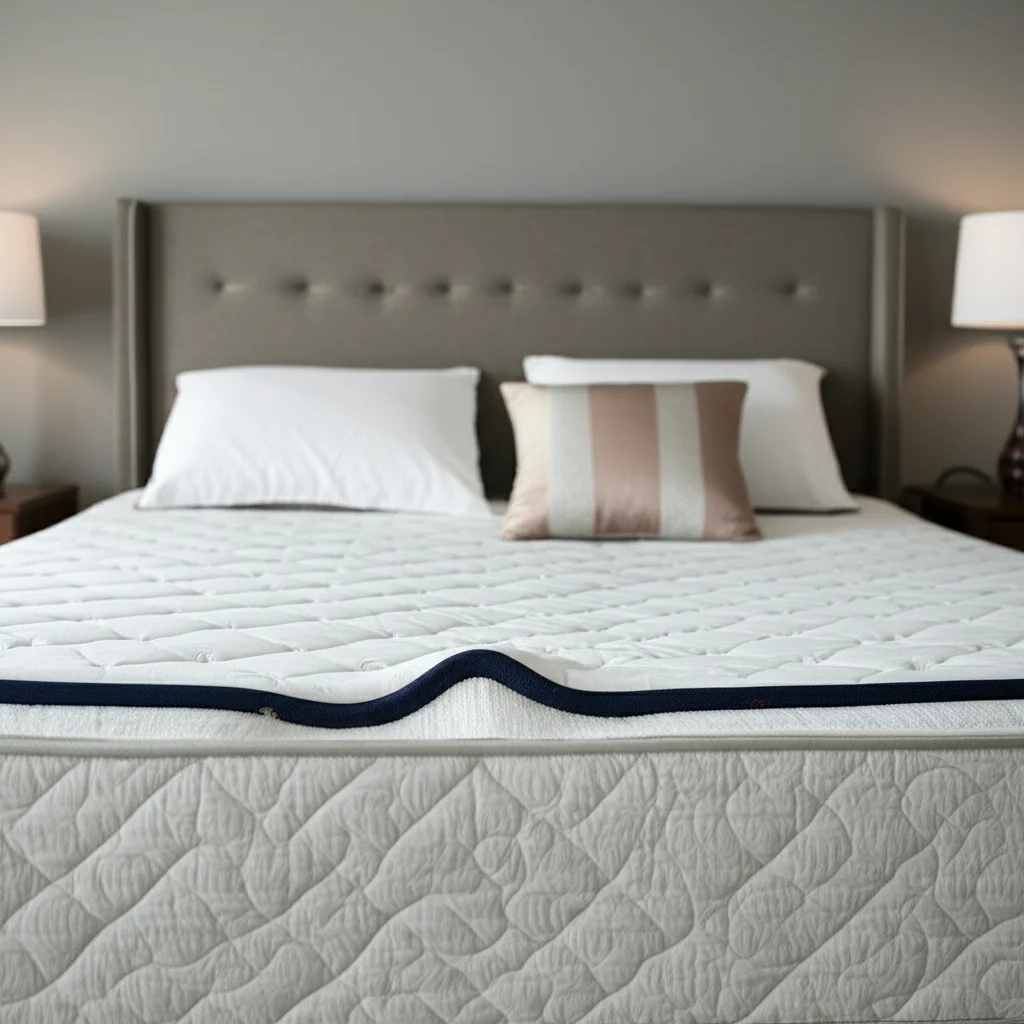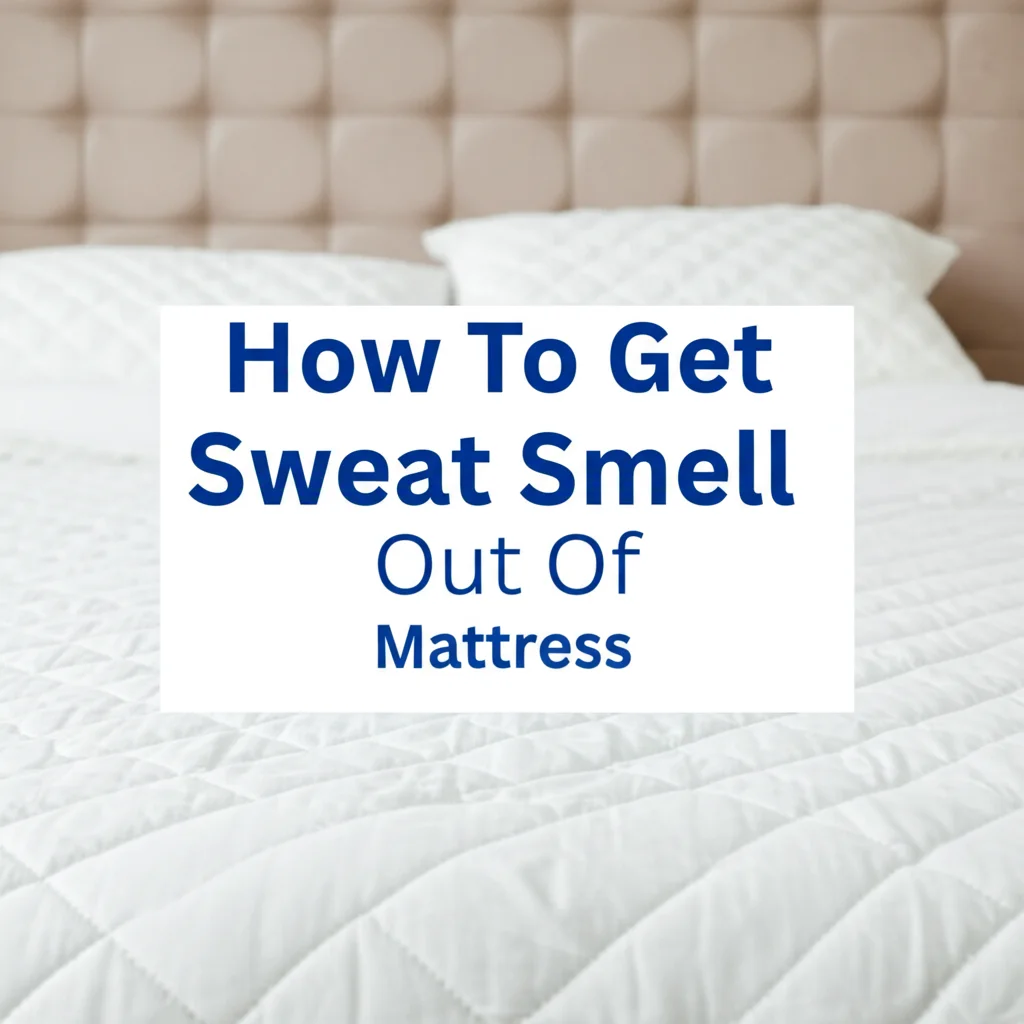· Todd Martin · Mattress Care · 19 min read
How To Remove Fuzz Balls From Mattress

Say Goodbye to Mattress Fuzz: How to Remove Fuzz Balls Easily
Waking up feeling refreshed is important. You want your mattress to be a clean, inviting place. But what happens when tiny, unsightly fuzz balls start to appear on its surface? These pesky little fiber clumps, also known as pilling, can make your otherwise comfortable bed feel less appealing. They can even make your mattress feel rough.
Dealing with mattress fuzz is a common household challenge. It is more than just an aesthetic issue. Excessive fuzz can trap dust, allergens, and even affect the feel of your sleep surface. I have faced this problem many times myself. It makes me wonder if my mattress is really clean. Knowing how to remove fuzz balls from mattress effectively ensures a cleaner, more hygienic, and visually appealing sleep environment. This guide will walk you through the causes of mattress pilling, the best tools to tackle it, and simple steps for removal. You will also learn how to prevent future fuzz formation, helping you keep your mattress in top condition.
Takeaway
- Understand Causes: Fuzz balls form from friction and fiber breakdown.
- Gather Tools: Use lint rollers, fabric shavers, or a clean razor.
- Remove Safely: Gently shave or roll the fuzz away from the surface.
- Prevent Future Fuzz: Employ mattress protectors and regular cleaning.
- Maintain Regularly: Vacuum and rotate your mattress often.
To remove fuzz balls from a mattress, gently shave the pilled areas with a fabric shaver or a clean, sharp razor, moving in small, controlled strokes. Alternatively, use a strong lint roller or vacuum cleaner with an upholstery attachment to lift surface fuzz. Always test on an inconspicuous area first.
Understanding Mattress Fuzz Balls: What Causes Them?
Have you ever wondered why those annoying little fuzz balls appear on your mattress? It is a common question. These small fiber clumps, often called pilling, are not a sign of a dirty home. They are a natural result of fabric wear. Understanding their origin helps you tackle them effectively.
The primary cause of fuzz balls is friction. When you move around on your mattress, the fibers on its surface rub against your sheets, blankets, and even your pajamas. This constant rubbing causes the short, loose fibers to break away from the main fabric. These detached fibers then intertwine with each other. They form those familiar little spheres that cling to the mattress surface. Different types of mattress fabrics react differently to this friction. Synthetic materials, like polyester blends, are often more prone to pilling than natural fibers. This is because synthetic fibers are strong. They do not break off easily, but they do tend to pill once they start to unravel.
Another contributing factor is the quality of the mattress fabric itself. Lower quality fabrics or those with shorter staple fibers are more likely to pill. The shorter fibers break more easily under stress. They then form fuzz balls quickly. Dust and skin cells can also get caught in these loose fibers. This makes the fuzz balls more noticeable and sometimes larger. Even pet hair can contribute to the problem. It gets tangled with loose fabric fibers. This creates more significant lint accumulation. Regular use and even improper cleaning methods can accelerate this process. It is important to know that pilling does not mean your mattress is falling apart. It simply indicates surface wear.
Essential Tools for Effective Fuzz Ball Removal
Before you begin the process of removing fuzz balls, you need the right tools. Using the correct items makes the job much easier and more effective. You also reduce the risk of damaging your mattress fabric. I always make sure I have these things ready before I start. Having the right tools on hand ensures a smooth and efficient cleaning process.
Fabric Shaver
A fabric shaver, also known as a lint remover or defuzzer, is specifically designed for this task. It has a rotating blade that safely shaves off fuzz balls without harming the underlying fabric. You simply glide the shaver over the pilled areas. The device collects the removed fuzz in a small compartment. Fabric shavers are excellent for large areas and offer a consistent result. They are gentle enough for most mattress materials. I find them very satisfying to use. It is like giving your mattress a haircut. This tool is often my first choice. It works quickly and cleanly.
Lint Roller
A sticky lint roller is a simple but effective tool for surface fuzz. It has adhesive sheets that pick up loose fibers, dust, and pet hair. While it might not remove deeply embedded fuzz balls, it is perfect for light pilling and daily maintenance. You just roll it across the mattress surface. The stickiness pulls the lint away. Lint rollers are great for a quick clean-up. They are also good for preparing the mattress before using a fabric shaver. Always keep a few spare sheets handy. They lose their stickiness quickly.
Conventional Razor
For a budget-friendly option, a new, clean conventional razor can work wonders. This method requires careful handling. You must use a gentle touch. Hold the razor almost flat against the mattress surface. Slowly, lightly glide it over the fuzz balls. The blade will cut them off. This method is surprisingly effective. However, it carries a small risk of cutting the fabric if you apply too much pressure. Always use a fresh razor blade. Dull blades can snag the fabric. This can cause more damage than good. Test it on an inconspicuous area first.
Vacuum Cleaner with Upholstery Attachment
Your vacuum cleaner is also a valuable tool for tackling mattress fuzz. A powerful vacuum with an upholstery attachment can effectively suction up loose fibers, dust, and smaller fuzz balls. This is especially useful for removing debris that might be trapped within the fuzz. It is also excellent for overall mattress hygiene. Regularly vacuuming your mattress helps prevent fuzz balls from forming. It removes the loose fibers before they can clump together. You can learn more about general deep cleaning for your mattress here: how to deep clean your mattress. I always vacuum my mattress after removing any fuzz. This ensures all the loose bits are gone.
Step-by-Step Guide to Removing Fuzz Balls Safely
Now that you have your tools ready, let us get to the actual process of removing those annoying fuzz balls. It is a straightforward process. But it requires a bit of patience and attention to detail. I follow these steps every time I need to refresh my mattress. It always yields great results.
Step 1: Prepare Your Mattress
First, strip your bed completely. Remove all sheets, blankets, pillows, and mattress toppers. You need full access to the mattress surface. This allows you to see all the affected areas clearly. It also prevents any obstructions during the cleaning process. Next, give your mattress a good vacuuming. Use the upholstery attachment on your vacuum cleaner. This removes any loose dust, dirt, crumbs, and pet hair. These particles can often be mixed with the fuzz balls. Removing them first makes the fuzz balls easier to target. A clean surface helps the fuzz removal tools work better. If you have any stains, you might want to address those too. Read about how to manage different stains here: how to clean mattress stains how to remove.
Step 2: Choose Your Removal Method
Select the tool you prefer based on the severity of the fuzz. For light fuzz and maintenance, a lint roller is a good start. For more significant pilling, a fabric shaver or a clean razor will be more effective.
Using a Fabric Shaver: Hold the fabric shaver flat against the mattress surface. Gently glide it over the pilled areas. Work in small sections. Apply light pressure. The shaver will cut off the fuzz balls. Watch as the compartment fills up with the removed lint. Empty it as needed. Repeat this process until the entire affected area is smooth. This method is generally safe and very efficient.
Using a Conventional Razor: If you are using a razor, exercise extreme caution. Place the razor at a very shallow angle to the mattress. Almost flat. Gently pull it across the pilled area in short, light strokes. Do not press hard. The goal is to slice off the fuzz, not to cut into the mattress fabric. Always use a new, sharp blade. A dull blade can snag and damage the fabric. Test this method on a hidden spot first. This helps you get a feel for the right pressure.
Using a Lint Roller: For quick touch-ups or minimal fuzz, simply roll the lint roller over the mattress surface. The sticky sheets will pick up loose fibers. Replace the adhesive sheets as they lose their stickiness. This method is fast and easy. However, it may not remove deeply embedded fuzz.
Step 3: Clean Up Remaining Debris
After removing the fuzz balls, you will likely have some loose fibers left on the mattress. Use your vacuum cleaner with the upholstery attachment again. Go over the entire mattress surface. This ensures all the detached fuzz and dust are completely removed. This step is crucial for a truly clean finish. For specific mattress types, cleaning methods might vary slightly. For example, if you have a foam mattress, be sure to check specific cleaning tips. You can find useful advice on how to clean a foam mattress here: how to clean foam mattress. Cleaning up thoroughly makes your efforts worthwhile. Your mattress will look and feel much better.
Advanced Techniques for Stubborn Fuzz and Pilling
Sometimes, fuzz balls are more than just surface nuisances. They can become deeply embedded or particularly stubborn. When your usual methods do not quite cut it, you might need to turn to some advanced techniques. These methods require a bit more care. But they can be very effective for persistent pilling. I have used these myself when faced with a really fuzzy situation.
The Pumice Stone or Sweater Comb Method
A pumice stone or a specialized sweater comb can work wonders on dense pilling. These tools are designed to gently scrape off fuzz without damaging the fabric underneath. They have a slightly abrasive surface. For a pumice stone, you simply glide it lightly over the pilled area in one direction. The rough surface catches the fuzz and pulls it away. For a sweater comb, you hold it at a slight angle. Then you make short, gentle strokes across the fabric. Both tools are very effective for removing stubborn, tightly packed fuzz. Always use a light touch. Applying too much pressure can damage your mattress fabric. Test it on a small, hidden spot first to ensure it does not cause any harm.
The Damp Cloth (for collecting)
While you should never get your mattress too wet, a slightly damp cloth can be useful for collecting already detached fuzz. After using a shaver or comb, some tiny fibers might remain. Lightly dampen a clean microfiber cloth. Then gently wipe it over the treated areas. The slight dampness helps the cloth pick up any remaining loose fibers and dust. This method is purely for collecting debris. It is not for removing the fuzz itself. Make sure the cloth is only damp, not wet. You do not want to introduce moisture into your mattress. Too much moisture can lead to mold or mildew.
Considering Professional Help for Severe Pilling
For extremely severe or widespread pilling, professional cleaning services might be an option. While this is less common for simple fuzz balls, if the fabric is heavily matted or damaged, a professional can assess the situation. They have specialized equipment and knowledge to handle delicate fabrics. They can often restore the mattress surface without causing further damage. This is usually a last resort. It is more expensive than DIY methods. However, it can be worth it for very valuable or sensitive mattresses. Especially if you have a special mattress type like a pillow-top. Pillow-top mattresses can sometimes have unique cleaning needs. You can learn more about how to clean a pillow top mattress here: how to clean pillow top mattress.
Preventing Future Fuzz Balls: Mattress Care Tips
Removing fuzz balls is great. But preventing them from forming in the first place is even better. A proactive approach to mattress care can significantly reduce the appearance of pilling. It helps extend the life of your mattress. I always advise people to integrate these simple habits into their routine. Prevention is key to a long-lasting, comfortable sleep surface.
Use a High-Quality Mattress Protector
This is arguably the most effective way to prevent fuzz balls. A good mattress protector acts as a barrier between your body, bedding, and the mattress surface. It shields the mattress fabric from friction. It also protects against spills, stains, and allergens. Look for a protector made from durable, smooth material. This material should not itself be prone to pilling. Regularly washing your mattress protector, according to its care instructions, is also important. This keeps it clean and effective. Using a protector is an investment in your mattress’s longevity. You can find useful guidance on how to clean a mattress protector here: how to clean mattress protector.
Regular Vacuuming and Spot Cleaning
Consistent cleaning helps remove loose fibers before they can clump into fuzz balls. Make it a habit to vacuum your mattress every few months. Use the upholstery attachment. This removes dust, pet hair, and any tiny fibers that have broken off. This prevents them from forming larger balls. If you notice any small spots or spills, address them immediately. Spot cleaning helps maintain the overall cleanliness of your mattress. It also prevents dirt from embedding into the fibers. This can contribute to future pilling. Learn more about effective spot cleaning techniques here: how to spot clean a mattress. Regular maintenance is a simple way to keep your mattress pristine.
Rotate or Flip Your Mattress Regularly
Rotating or flipping your mattress, as recommended by the manufacturer, distributes wear evenly. This means no one area of the mattress is subjected to constant friction. By regularly changing the stress points, you reduce the likelihood of localized pilling. Most modern mattresses are designed to be rotated head-to-foot. Some older or two-sided mattresses can be flipped. Check your mattress’s care label or manufacturer guidelines. This simple action can make a big difference in preventing wear patterns.
Proper Laundry Care for Bedding
Your sheets and blankets also play a role in mattress pilling. Rough or abrasive bedding can contribute to friction. This leads to fuzz ball formation on your mattress. Wash your bedding according to its care instructions. Avoid harsh detergents or fabric softeners that can leave residue. Residue might attract more lint. Ensure your sheets are completely dry before putting them back on the bed. This prevents moisture issues. Consider using softer, smoother bedding materials like high-thread-count cotton or silk. These are less likely to cause friction.
When to Consider a New Mattress (Beyond Fuzz)
While removing fuzz balls can significantly improve your mattress’s appearance, there comes a point when cleaning is no longer enough. Fuzz balls are a sign of surface wear. But they are usually not a reason to replace a mattress on their own. However, if you notice other signs of wear and tear, it might be time for a new one. I think about these signs carefully. My sleep quality depends on it.
One major indicator is sagging. If your mattress has visible dips or indentations where you sleep, it is losing its support. This can lead to back pain or stiffness. Your body needs proper alignment during sleep. Sagging means it is not getting that. Another sign is persistent discomfort. If you wake up with aches and pains, or if you toss and turn all night, your mattress might be the culprit. It simply might not be providing the right level of support anymore. Every mattress has a lifespan.
Strange noises can also signal a problem. Squeaking or creaking sounds from an innerspring mattress can mean the coils are worn out. These sounds often get worse over time. They indicate a breakdown in the internal structure. Allergies worsening at night could also point to an old mattress. Mattresses can accumulate allergens like dust mites, mold, and pet dander over years. Even with regular cleaning, these can become deeply embedded.
Lastly, consider the age of your mattress. Most mattresses last between 7 to 10 years. After this time, materials degrade. They lose their supportive properties. Even if it looks okay, an old mattress may not provide the same benefits. It will not support you properly. Fuzz balls are a small cosmetic issue. But if they appear alongside these other problems, it is time to think about a replacement. Knowing when your mattress is too soft can also be a key indicator of its age and wear. You can learn more about this here: how to tell if mattress is too soft.
Common Mistakes to Avoid When Cleaning Mattress Fuzz
Cleaning mattress fuzz seems simple. However, some common mistakes can actually harm your mattress or make the problem worse. Avoiding these pitfalls ensures your cleaning efforts are effective and safe. I have learned these lessons over time. It is better to prevent damage than to fix it.
Over-Wetting the Mattress
One of the biggest mistakes is using too much liquid. Mattresses are not designed to get wet. Excessive moisture can penetrate the layers. It promotes mold and mildew growth. This can lead to unpleasant odors. It can also damage the internal components. When spot cleaning or using a damp cloth, ensure it is only slightly damp. Never saturate the fabric. Always allow the mattress to air dry completely before replacing bedding. Proper drying prevents serious issues.
Using Harsh Chemicals
Avoid using strong, abrasive, or undiluted chemical cleaners on your mattress. These chemicals can bleach the fabric. They can break down mattress materials. They can also leave behind harmful residues. These residues might irritate your skin or respiratory system. Stick to gentle, fabric-safe solutions. For example, mild soap diluted in water or specialized fabric cleaners. Always test any cleaner on a small, hidden area first. This checks for discoloration or damage.
Aggressive Scrubbing
Scrubbing too hard can damage the mattress fabric. It can break fibers. This actually creates more fuzz balls. It can also weaken the material. This makes it more prone to future pilling. Always use gentle motions. Whether you are using a fabric shaver or a razor, light, controlled strokes are best. Let the tool do the work. Do not force it. Your mattress needs gentle care.
Ignoring Initial Vacuuming
Skipping the initial vacuuming step is a common oversight. Vacuuming before tackling fuzz balls removes loose debris. This includes dust, pet hair, and surface lint. These particles can get in the way of your fuzz removal tools. They can also get pushed deeper into the fabric. A clean starting surface allows the fabric shaver or razor to work more efficiently. It also leaves your mattress much cleaner overall. Do not underestimate the power of a good vacuum.
Using a Dull Razor
If you choose to use a conventional razor, ensure it is brand new and sharp. A dull razor will not cut the fuzz cleanly. Instead, it will snag and pull at the mattress fibers. This can damage the fabric and worsen the pilling. It can also create snags. Always use a fresh blade. Dispose of it properly after use. Safety comes first.
FAQ Section
Q1: Why do fuzz balls appear on mattresses?
Fuzz balls, or pilling, form primarily due to friction. When you move on your mattress, the constant rubbing against sheets and pajamas causes short, loose fibers on the mattress surface to break away. These detached fibers then intertwine and clump together, creating the small balls. Fabric quality and type also play a role, with some materials being more prone to pilling than others.
Q2: Can I use a regular razor to remove fuzz from my mattress?
Yes, you can use a new, clean conventional razor to remove fuzz balls from your mattress. This method requires careful handling. Hold the razor at a very shallow angle to the mattress surface. Gently glide it over the pilled areas. Do not apply too much pressure, as this can cut or damage the mattress fabric. Always test on an inconspicuous area first.
Q3: Is a lint roller enough for mattress fuzz?
A lint roller is effective for removing light surface fuzz, loose fibers, dust, and pet hair. It is excellent for quick touch-ups and regular maintenance. However, for more stubborn or deeply embedded fuzz balls, a lint roller may not be sufficient. In those cases, a fabric shaver or careful use of a conventional razor will be more effective.
Q4: How often should I clean my mattress for fuzz?
The frequency depends on how quickly fuzz balls appear on your mattress. For general maintenance and to prevent fuzz buildup, a light vacuuming with an upholstery attachment every few months is beneficial. If you notice persistent pilling, you can use a fabric shaver or razor as needed, perhaps once or twice a year, or whenever the fuzz becomes noticeable.
Q5: Does a mattress protector prevent fuzz balls?
Yes, a high-quality mattress protector is one of the best ways to prevent fuzz balls. It creates a physical barrier between your body, bedding, and the mattress surface. This barrier reduces the friction that causes fibers to break and clump together. A protector also helps keep your mattress cleaner by guarding against spills, stains, and allergens.
Q6: What if the fuzz balls are really embedded?
For deeply embedded or stubborn fuzz balls, consider using advanced tools like a pumice stone or a specialized sweater comb. These tools are designed to gently scrape off more resilient pilling. Glide them lightly over the affected areas. If the pilling is extremely severe and widespread, and regular methods fail, professional mattress cleaning services might be an option.
Conclusion
Saying goodbye to those annoying fuzz balls on your mattress is achievable. It does not require a lot of special equipment. You can enjoy a clean, smooth sleeping surface with a few simple tools and techniques. We covered the reasons fuzz balls appear, from friction to fabric wear. Then we explored the most effective tools for removal, like fabric shavers, lint rollers, and even a conventional razor used carefully. I find that a combination of these often works best.
By following the step-by-step guide, you can confidently remove existing fuzz. Remember to prepare your mattress by vacuuming first. Then use your chosen method gently. Always clean up any remaining debris afterward. More importantly, you now have the knowledge to prevent future fuzz. Using a mattress protector, regular vacuuming, and proper bedding care are crucial. These habits extend the life and cleanliness of your mattress. Maintaining your mattress ensures you have a hygienic and comfortable sleep environment. Invest a little time in these simple steps. You will enjoy a fuzz-free mattress for years to come. Your sleep quality will thank you.





